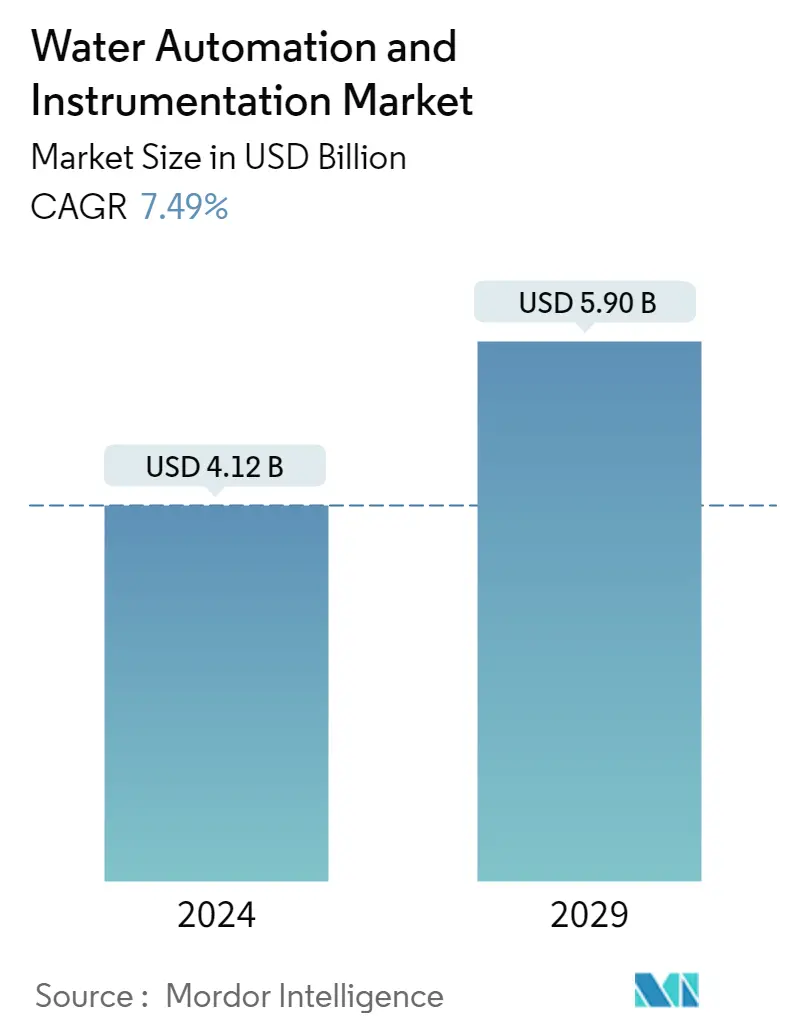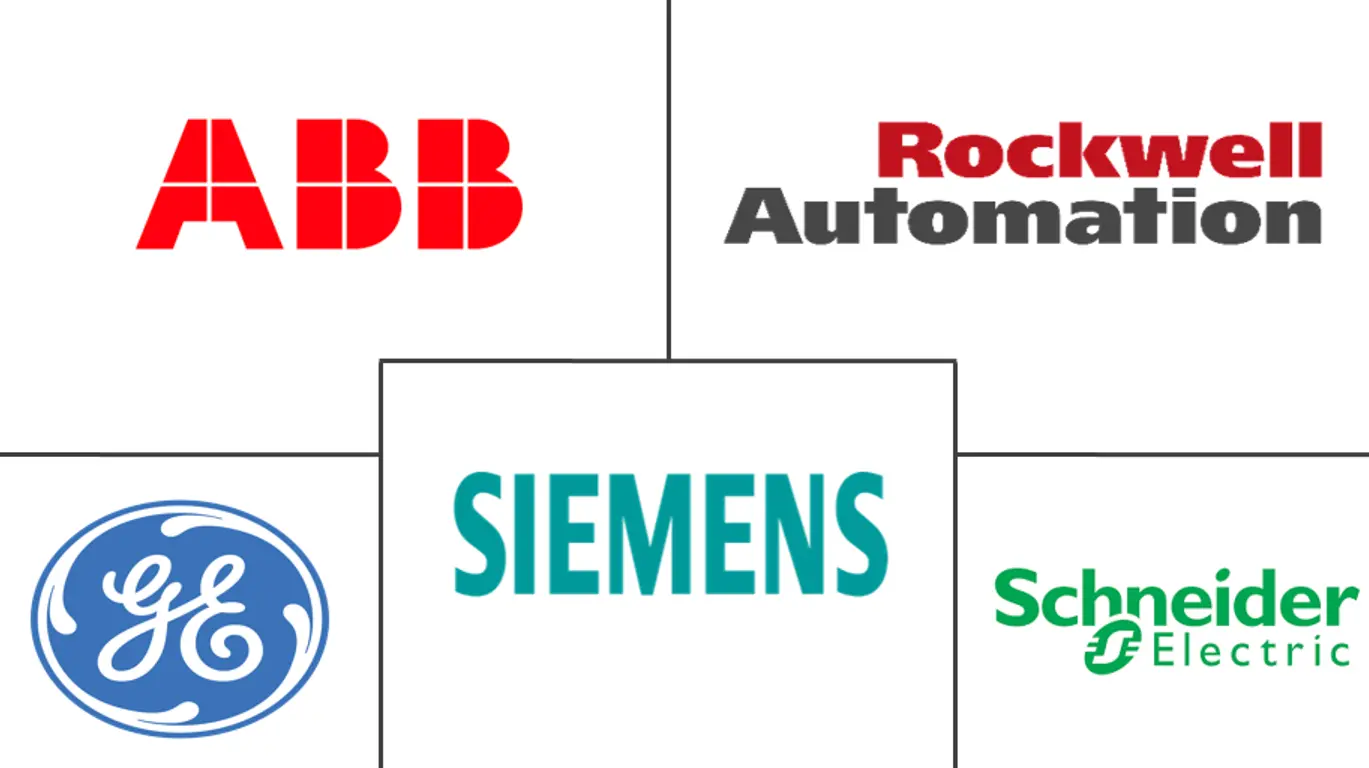Market Size of Water Automation and Instrumentation Industry

| Study Period | 2019 - 2029 |
| Market Size (2024) | USD 4.12 Billion |
| Market Size (2029) | USD 5.90 Billion |
| CAGR (2024 - 2029) | 7.49 % |
| Fastest Growing Market | Asia Pacific |
| Largest Market | North America |
Major Players
*Disclaimer: Major Players sorted in no particular order |
Water Automation And Instrumentation Market Analysis
The Water Automation and Instrumentation Market size is estimated at USD 4.12 billion in 2024, and is expected to reach USD 5.90 billion by 2029, growing at a CAGR of 7.49% during the forecast period (2024-2029).
The COVID-19 pandemic considerably hampered the production of water automation instrumentation at the beginning of 2020. This is because the lockdown imposed in several countries to curb the spread of the COVID-19 virus caused considerable disruptions in the global supply chain of the parts and components used in the water and wastewater landscape instruments.
- Managing operational costs emerged as one of the biggest challenges posed by stakeholders of the water industry, as the governments are imposing regulations, along with depletion of potable water resources. Expenses relating to labor and energy constitute the largest share in OPEX for water utilities.
- The increasing health concerns for preventing water-borne diseases among consumers augmented the consumption of bottled drinking water. Furthermore, this trend led to an increase in infrastructure development investments that support the water automation market.
- There has been an increase in the use of decentralized control systems, with the rise in the number of outstations and varied qualities of water in a region. Automation solutions, such as PLC, help in controlling pump station motor contactors, stirrer motors, and distributed valves, as well as to measure the pressure transmitter of the water.
- Water instrumentation solutions, such as liquid analyzers and level transmitters, are helping chemical and pharmaceutical industries maintain precision. The high prices of specific sensors might increase the cost of such instruments. However, reduced operational costs due to the users are expected to decline the total cost of ownership.
- Technological innovations include taking advantage of previously unusable supplies through improved water desalination and increased industrial efficiency through new water reclaiming technologies. A new breed of water tech automation solutions, especially the Internet of Things (IoT)-based control and monitoring systems combined with SCADA software for water management, are solutions that can be explored to help begin to solve certain issues.
Water Automation And Instrumentation Industry Segmentation
The water automation system and instrumentation is based on real-time operating systems and programming toolkit that solves the current global issues, such as potable water shortage, poor water quality, high processing monitors, energy savings, and supply costs. The study covers the dynamics of multiple water automation solutions, such as DCS, SCADA, PLC, and water instruments, such as pressure transmitters, level transmitters, and liquid and gas analyzers.
| Water Automation Solution | |
| DCS | |
| SCADA | |
| PLC | |
| IAM | |
| HMI | |
| Other Water Automation Solutions |
| Water Instrumentation Solution | |
| Pressure Transmitter | |
| Level Transmitter | |
| Temperature Transmitter | |
| Liquid Analyzers | |
| Gas Analyzers | |
| Leakage Detection Systems | |
| Flow Sensors/Transmitters | |
| Other Water Instrumentation Solutions |
| End-user Industry | |
| Chemical | |
| Manufacturing | |
| Food and Beverages | |
| Utilities | |
| Paper and Pulp | |
| Other End-user Industries |
| Geography | |||||||
| |||||||
| |||||||
| |||||||
| Latin America | |||||||
|
Water Automation and Instrumentation Market Size Summary
The Water Automation and Instrumentation Market is poised for significant growth over the forecast period, driven by increasing demand for efficient water management solutions. The market is experiencing a resurgence following the disruptions caused by the COVID-19 pandemic, which had a substantial impact on production and supply chains. Key factors propelling market expansion include the rising need to manage operational costs amidst regulatory pressures and the depletion of potable water resources. The growing health concerns related to water-borne diseases have further fueled investments in infrastructure development, supporting the adoption of advanced water automation technologies. Decentralized control systems and automation solutions, such as PLCs, are becoming increasingly prevalent, enhancing the efficiency of water management processes across various sectors.
In the food and beverage industry, the implementation of water and wastewater automation is proving to be a game-changer, offering substantial cost savings and improved operational efficiency. Companies are leveraging advanced instrumentation technologies to ensure water quality and reduce wastewater volume, thereby enhancing productivity and profit margins. The market is characterized by a fragmented landscape with intense competition among major players, including ABB Group, Siemens AG, and Schneider Electric SE, among others. Strategic acquisitions and partnerships are being pursued to enhance technical expertise and expand market presence. Innovations in IoT-based control systems and SCADA software are set to address ongoing challenges, while technological advancements in water desalination and reclaiming technologies are expected to further drive market growth.
Water Automation and Instrumentation Market Size - Table of Contents
-
1. MARKET DYNAMICS
-
1.1 Market Overview
-
1.2 Market Drivers
-
1.2.1 Government Regulation to Save Water Resources and Energy
-
1.2.2 Increase in Adoption of Smart Water Technologies
-
-
1.3 Market Restraints
-
1.3.1 Lack of Skilled Personnel to Operate Instrumentation
-
-
1.4 Industry Value Chain Analysis
-
1.5 Industry Attractiveness - Porter's Five Force Analysis
-
1.5.1 Threat of New Entrants
-
1.5.2 Bargaining Power of Buyers/Consumers
-
1.5.3 Bargaining Power of Suppliers
-
1.5.4 Threat of Substitute Products
-
1.5.5 Intensity of Competitive Rivalry
-
-
1.6 Assessment of the COVID-19 Impact on the Market
-
-
2. MARKET SEGMENTATION
-
2.1 Water Automation Solution
-
2.1.1 DCS
-
2.1.2 SCADA
-
2.1.3 PLC
-
2.1.4 IAM
-
2.1.5 HMI
-
2.1.6 Other Water Automation Solutions
-
-
2.2 Water Instrumentation Solution
-
2.2.1 Pressure Transmitter
-
2.2.2 Level Transmitter
-
2.2.3 Temperature Transmitter
-
2.2.4 Liquid Analyzers
-
2.2.5 Gas Analyzers
-
2.2.6 Leakage Detection Systems
-
2.2.7 Flow Sensors/Transmitters
-
2.2.8 Other Water Instrumentation Solutions
-
-
2.3 End-user Industry
-
2.3.1 Chemical
-
2.3.2 Manufacturing
-
2.3.3 Food and Beverages
-
2.3.4 Utilities
-
2.3.5 Paper and Pulp
-
2.3.6 Other End-user Industries
-
-
2.4 Geography
-
2.4.1 North America
-
2.4.1.1 United States
-
2.4.1.2 Canada
-
-
2.4.2 Europe
-
2.4.2.1 Germany
-
2.4.2.2 United Kingdom
-
2.4.2.3 France
-
2.4.2.4 Italy
-
2.4.2.5 Rest of Europe
-
-
2.4.3 Asia Pacific
-
2.4.3.1 Australia
-
2.4.3.2 China
-
2.4.3.3 Japan
-
2.4.3.4 India
-
2.4.3.5 Rest of Asia Pacific
-
-
2.4.4 Latin America
-
2.4.5 Middle East and Africa
-
2.4.5.1 Saudi Arabia
-
2.4.5.2 United Arab Emirates
-
2.4.5.3 Rest of Middle East and Africa
-
-
-
Water Automation and Instrumentation Market Size FAQs
How big is the Water Automation and Instrumentation Market?
The Water Automation and Instrumentation Market size is expected to reach USD 4.12 billion in 2024 and grow at a CAGR of 7.49% to reach USD 5.90 billion by 2029.
What is the current Water Automation and Instrumentation Market size?
In 2024, the Water Automation and Instrumentation Market size is expected to reach USD 4.12 billion.

